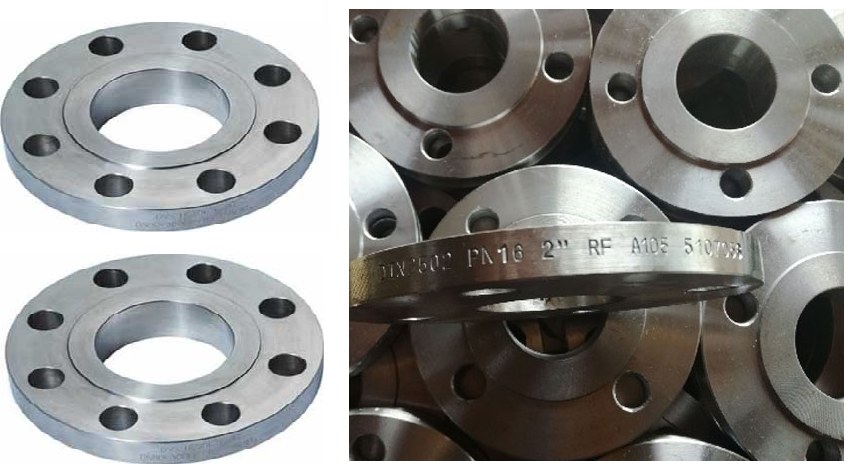What is Difference Between FF and RF Flanges?
Flanges play a pivotal role in a variety of industries, from petrochemicals to construction, by enabling the secure connection of pipes, valves, and equipment. When selecting flanges, it’s crucial to understand their types and specifications. Among the most common types are FF (Flat Face) and RF (Raised Face) flanges, which serve distinct purposes and have unique characteristics. In this article, we will delve into the differences between FF and RF flanges to help you make informed choices for your specific applications.

1. Facing Types:
– FF (Flat Face) Flanges: As the name suggests, flat face flanges have a smooth and flat surface perpendicular to the pipe. These flanges are designed for applications where sealing is achieved by using gaskets. The flat surface facilitates even distribution of the compressive load on the gasket, ensuring a leak-free connection.
– RF (Raised Face) Flanges: Raised face flanges, on the other hand, have a raised ring or face around the bore. This raised face acts as a compression stop, allowing the use of a gasket for a reliable seal. RF flanges are ideal for applications where a tighter and more secure sealing is required.
2. Sealing Method:
– FF Flanges: Flat face flanges rely on gaskets for sealing. These gaskets are placed between the flange faces and compressed during assembly to create a seal. FF flanges are commonly used in low-pressure applications and with non-metallic gaskets.
– RF Flanges: Raised face flanges also utilize gaskets for sealing but provide a more robust sealing mechanism due to the raised face. They are preferred for higher-pressure applications and are compatible with a wider range of gasket materials.
3. Pressure Ratings:
– FF Flanges: Flat face flanges are generally suitable for lower-pressure applications. Their design may not withstand the same level of pressure as RF flanges.
– RF Flanges: Raised face flanges are capable of handling higher pressure and temperature conditions. The raised face design enhances their ability to maintain a tight seal under increased loads.
4. Gasket Material Compatibility:
– FF Flanges: Flat face flanges are typically used with non-metallic gaskets, such as rubber or compressed fiber gaskets. These gaskets work effectively with the flat sealing surface.
– Raised Face (RF) Flanges: RF flanges provide a versatile solution for gasket material selection, accommodating a diverse range of options, from metallic to non-metallic gasket materials.
5. Applications:
– FF Flanges: Flat face flanges are commonly used in industries with lower-pressure requirements, such as water treatment, HVAC systems, and certain chemical processes.
– RF Flanges: Raised face flanges are employed in applications demanding higher pressure and temperature resistance, such as oil and gas pipelines, refineries, and power generation facilities.
6. Cost Considerations:
– FF Flanges: Flat face flanges are generally more cost-effective compared to RF flanges. They are often chosen for budget-conscious projects with lower pressure requirements.
– RF Flanges: Raised face flanges tend to be more expensive due to their enhanced design and ability to handle higher pressure. They are an investment for applications where reliability and safety are paramount.
7. Installation Complexity:
– FF Flanges: Flat face flanges are simpler to install, as the flat surface allows for straightforward alignment and gasket placement.
– RF Flanges: Raised face flanges may require more precise alignment during installation due to the raised face design, which necessitates careful positioning of the gasket.
8. Maintenance and Repairs:
– FF Flanges: Maintenance and repairs of flat face flanges are generally more straightforward, thanks to their simplicity. Gasket replacement is relatively uncomplicated.
– RF Flanges: Raised face flanges may require more attention during maintenance and repair due to the precision needed when dealing with the raised face and gasket replacement.
conclusion
The choice between FF and RF flanges depends on the specific requirements of your application. FF flanges are suitable for low-pressure, budget-conscious projects with simpler installation and maintenance needs, while RF flanges excel in high-pressure, high-temperature applications where reliability and tight sealing are essential. Understanding the distinctions between these two flange types is crucial in ensuring the success and safety of your projects.
READ MORE: WHAT IS BUTTON HEAD SCREWS , AND PROPERTIES , APPLICATIONS
READ MORE: How to start a new startup business on Deepawali 2023




